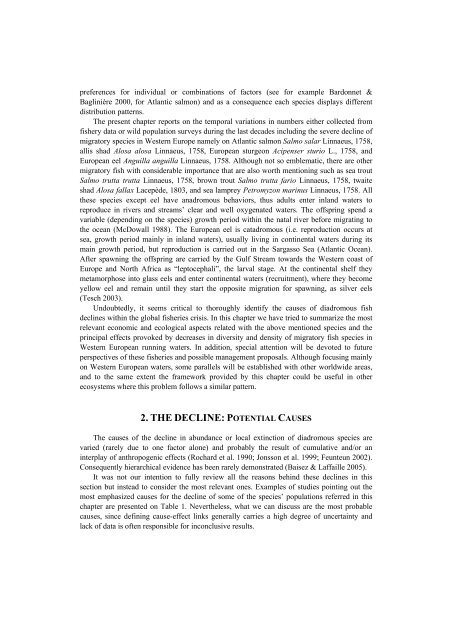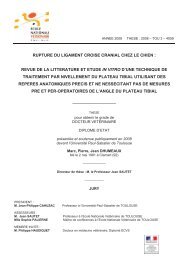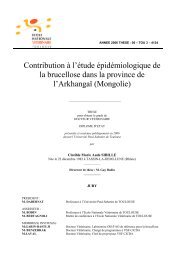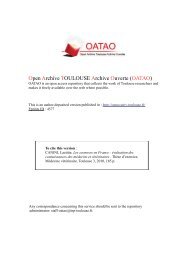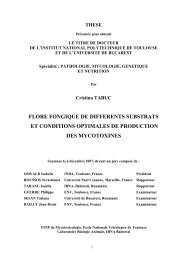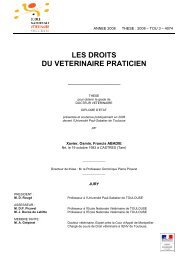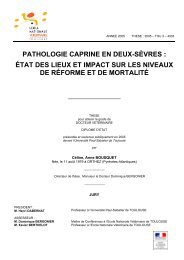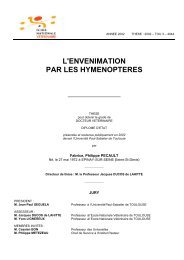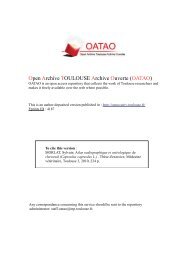PDF ( Author's version) - OATAO (Open Archive Toulouse Archive ...
PDF ( Author's version) - OATAO (Open Archive Toulouse Archive ...
PDF ( Author's version) - OATAO (Open Archive Toulouse Archive ...
You also want an ePaper? Increase the reach of your titles
YUMPU automatically turns print PDFs into web optimized ePapers that Google loves.
preferences for individual or combinations of factors (see for example Bardonnet &<br />
Baglinière 2000, for Atlantic salmon) and as a consequence each species displays different<br />
distribution patterns.<br />
The present chapter reports on the temporal variations in numbers either collected from<br />
fishery data or wild population surveys during the last decades including the severe decline of<br />
migratory species in Western Europe namely on Atlantic salmon Salmo salar Linnaeus, 1758,<br />
allis shad Alosa alosa Linnaeus, 1758, European sturgeon Acipenser sturio L., 1758, and<br />
European eel Anguilla anguilla Linnaeus, 1758. Although not so emblematic, there are other<br />
migratory fish with considerable importance that are also worth mentioning such as sea trout<br />
Salmo trutta trutta Linnaeus, 1758, brown trout Salmo trutta fario Linnaeus, 1758, twaite<br />
shad Alosa fallax Lacepède, 1803, and sea lamprey Petromyzon marinus Linnaeus, 1758. All<br />
these species except eel have anadromous behaviors, thus adults enter inland waters to<br />
reproduce in rivers and streams’ clear and well oxygenated waters. The offspring spend a<br />
variable (depending on the species) growth period within the natal river before migrating to<br />
the ocean (McDowall 1988). The European eel is catadromous (i.e. reproduction occurs at<br />
sea, growth period mainly in inland waters), usually living in continental waters during its<br />
main growth period, but reproduction is carried out in the Sargasso Sea (Atlantic Ocean).<br />
After spawning the offspring are carried by the Gulf Stream towards the Western coast of<br />
Europe and North Africa as “leptocephali”, the larval stage. At the continental shelf they<br />
metamorphose into glass eels and enter continental waters (recruitment), where they become<br />
yellow eel and remain until they start the opposite migration for spawning, as silver eels<br />
(Tesch 2003).<br />
Undoubtedly, it seems critical to thoroughly identify the causes of diadromous fish<br />
declines within the global fisheries crisis. In this chapter we have tried to summarize the most<br />
relevant economic and ecological aspects related with the above mentioned species and the<br />
principal effects provoked by decreases in diversity and density of migratory fish species in<br />
Western European running waters. In addition, special attention will be devoted to future<br />
perspectives of these fisheries and possible management proposals. Although focusing mainly<br />
on Western European waters, some parallels will be established with other worldwide areas,<br />
and to the same extent the framework provided by this chapter could be useful in other<br />
ecosystems where this problem follows a similar pattern.<br />
2. THE DECLINE: POTENTIAL CAUSES<br />
The causes of the decline in abundance or local extinction of diadromous species are<br />
varied (rarely due to one factor alone) and probably the result of cumulative and/or an<br />
interplay of anthropogenic effects (Rochard et al. 1990; Jonsson et al. 1999; Feunteun 2002).<br />
Consequently hierarchical evidence has been rarely demonstrated (Baisez & Laffaille 2005).<br />
It was not our intention to fully review all the reasons behind these declines in this<br />
section but instead to consider the most relevant ones. Examples of studies pointing out the<br />
most emphasized causes for the decline of some of the species’ populations referred in this<br />
chapter are presented on Table 1. Nevertheless, what we can discuss are the most probable<br />
causes, since defining cause-effect links generally carries a high degree of uncertainty and<br />
lack of data is often responsible for inconclusive results.


